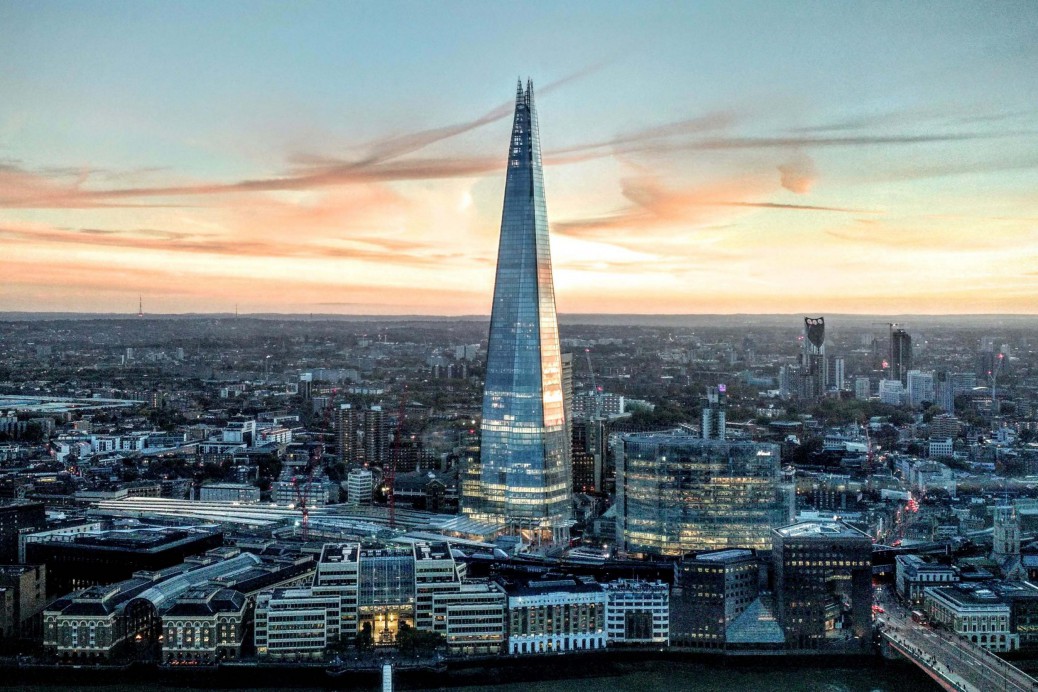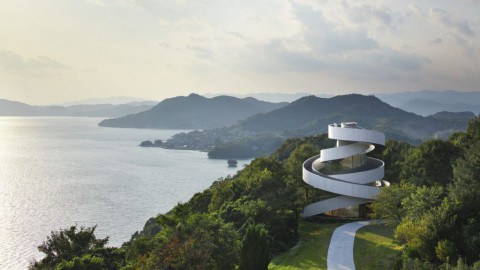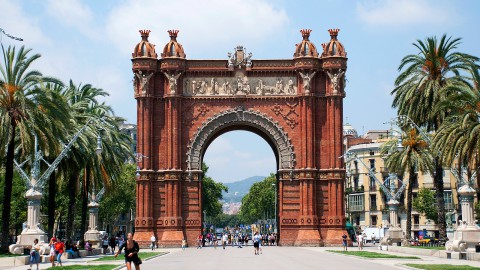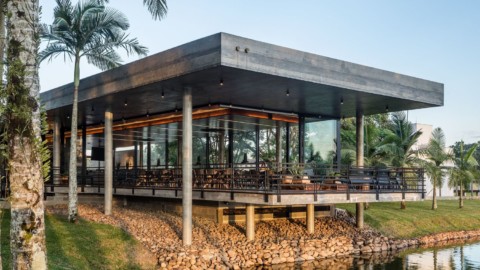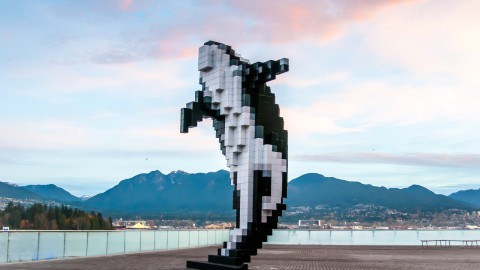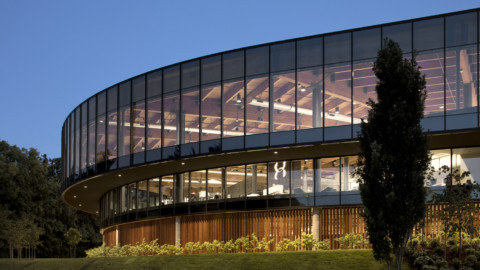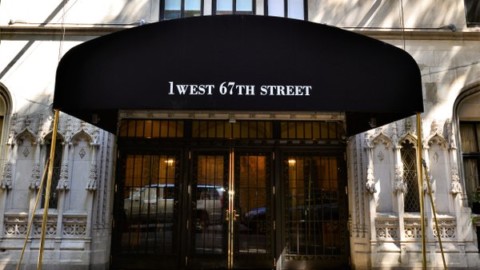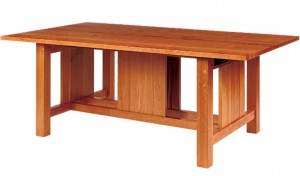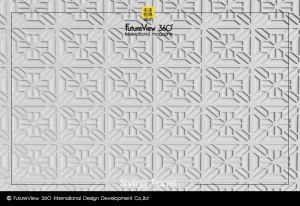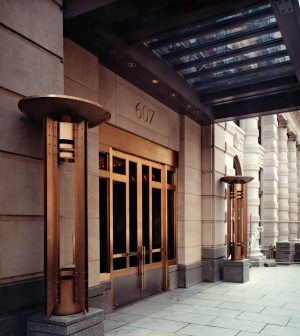The Shard 碎片大樓
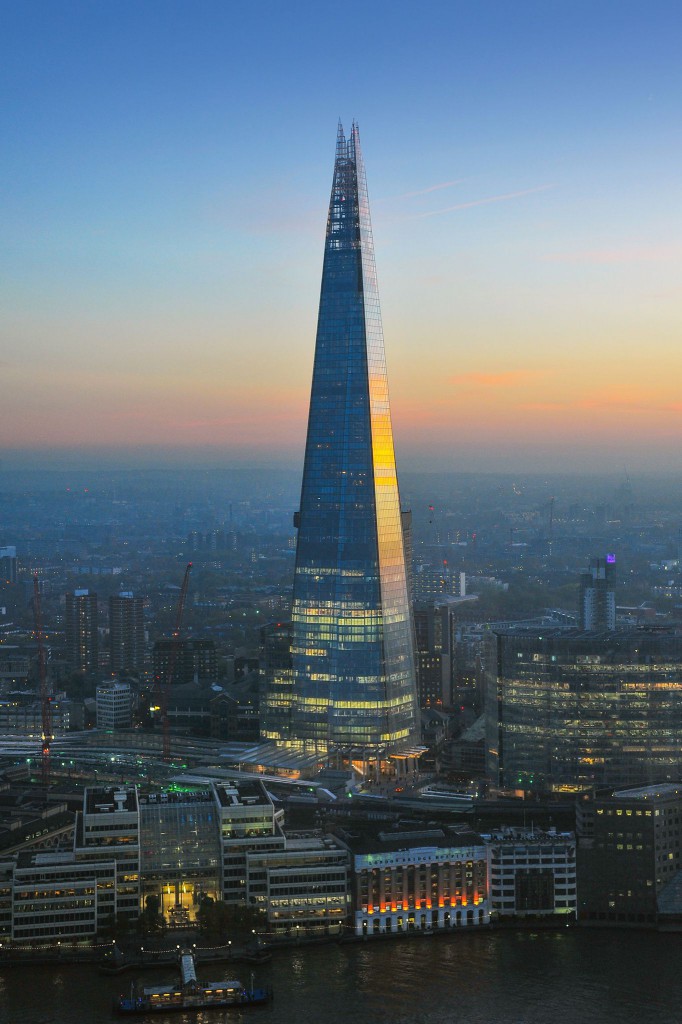
The Shard, also infrequently referred to as the Shard of Glass, Shard London Bridge and formerly London Bridge Tower, is a 95-story supertall skyscraper, designed by the Italian architect Renzo Piano, in Southwark, London, that forms part of the Shard Quarter development. Standing 309.7 metres (1,016 ft) high, the Shard is the tallest building in the United Kingdom, the tallest building in the European Union, the fifth-tallest building in Europe. It is also the second-tallest free-standing structure in the United Kingdom, after the concrete tower of the Emley Moor transmitting station. It replaced Southwark Towers, a 24-story office block built on the site in 1975.
The Shard’s construction began in March 2009; it was topped out on 30 March 2012 and inaugurated on 5 July 2012. Practical completion was achieved in November 2012. The tower’s privately operated observation deck, The View from The Shard, was opened to the public on 1 February 2013. The glass-clad pyramidal tower has 72 habitable floors, with a viewing gallery and open-air observation deck on the 72nd floor, at a height of 244 metres (801 ft). The Shard was developed by Sellar Property Group on behalf of LBQ Ltd and is jointly owned by Sellar Property (5%) and the State of Qatar (95%). The Shard is managed by Real Estate Management (UK) Limited on behalf of the owners.
碎片,也很少被稱為玻璃碎片,碎片倫敦橋和以前的倫敦橋塔,是一座95層高的超高層摩天大樓,由意大利建築師Renzo Piano設計,位於倫敦南華克,是Shard Quarter的一部分發展。 Shard高309.7米(1,016英尺),是英國最高的建築,是歐盟最高的建築,也是歐洲第五高的建築。它也是英國第二高的獨立式建築,位於Emley Moor發射台的混凝土塔之後。它取代了Southwark Towers,這是一座建於1975年的24層辦公大樓。
Shard的建設始於2009年3月;它於2012年3月30日完成,並於2012年7月5日落成。實際完工於2012年11月完成。塔樓的私人觀景台The Shard of the Shard於2013年2月1日向公眾開放。玻璃包層金字塔塔樓有72個可居住的樓層,在72樓有一個觀景廊和露天觀景台,高度為244米(801英尺)。 Shard由Sellar Property Group代表LBQ Ltd開發,由Sellar Property(5%)和卡塔爾國(95%)共同擁有。碎片由房地產管理(英國)有限公司代表業主管理。
Record height
Tallest in the United Kingdom since 2012
Preceded by:One Canada Square
General information
Status:Complete
Architectural style:Neo-futurism
Location:London, SE1
United Kingdom
Coordinates:51.5045°N 0.0865°WCoordinates: 51.5045°N 0.0865°W
Construction started:March 2009
Completed:July 2012
Opening:1 February 2013
Cost:~£435,023,452 (contract cost only)
Owner:State of Qatar (95%)
Sellar Property Group (5%)
Height
Architectural:309.7 m (1,016 ft)
Observatory:244 m (801 ft)
Technical details
Floor count:96 (72 habitable)
Floor area:398,490m2 1,307,383sqft
Lifts/elevators:36
Design and construction
Architect:Renzo Piano
Developer:Sellar Property Group
Structural engineer:WSP Global (structural engineers), Robert Bird Group (concrete temporary works), Ischebeck Titan on most floors 40+ (concrete support)
Services engineer:Arup
Main contractor:Mace
記錄高度
自2012年以來在英國最高
前:加拿大廣場一號
一般信息
狀態:已完成
建築風格:新未來主義
地點:倫敦,SE1
英國
坐標:51.5045°N 0.0865°W坐標:51.5045°N 0.0865°W
施工開始:2009年3月
完成時間:2012年7月
開幕時間:2013年2月1日
費用:~435,023,452英鎊(僅限合同費用)
所有者:卡塔爾國(95%)
塞拉爾地產集團(5%)
高度
建築:309.7米(1,016英尺)
天文台:244米(801英尺)
技術細節
樓層數:96(72居住)
建築面積:398,490平方米,1,307,383平方英尺
升降機/電梯:36
設計和施工
建築師:Renzo Piano
開發商:Sellar Property Group
結構工程師:WSP Global(結構工程師),Robert Bird Group(具體臨時工程),Ischebeck Titan,大多數樓層40+(混凝土支撐)
服務工程師:Arup
主承包商:梅斯
Background
Planning
In 1998, London-based entrepreneur Irvine Sellar and his then-partners decided to redevelop the 1970s-era Southwark Towers following a UK government white paper encouraging the development of tall buildings at major transport hubs. Sellar flew to Berlin in the spring of 2000 to meet the Italian architect Renzo Piano for lunch. According to Sellar, Piano spoke of his contempt for conventional tall buildings during the meal, before flipping over the restaurant’s menu and sketching a spire-like sculpture emerging from the River Thames.
In July 2002, the then-Deputy Prime Minister, John Prescott, ordered a planning inquiry after the development plans for the Shard were opposed by the Commission for Architecture and the Built Environment and several heritage bodies, including the Royal Parks Foundation and English Heritage. The inquiry took place in April and May 2003, and on 19 November 2003, the Office of the Deputy Prime Minister announced that planning consent had been approved. The government stated that:
Mr Prescott would only approve skyscrapers of exceptional design. For a building of this size to be acceptable, the quality of its design is critical. He is satisfied that the proposed tower is of the highest architectural quality.
Sellar and his original partners CLS Holdings plc and CN Ltd (acting for the Halabi Family Trust) secured an interim funding package of £196 million in September 2006 from the Nationwide Building Society and Kaupthing Singer & Friedlander. This enabled them to pay off the costs already incurred and to buy out the Southwark Towers occupational lease from the building’s tenants, PricewaterhouseCoopers. Vacant possession of the site was secured a year later, after PricewaterhouseCoopers completed the relocation of their operations.
In September 2007, preparations for the demolition of Southwark Towers began. However, later that same month, turbulence in the financial markets reportedly put the Shard’s construction in jeopardy, threatening to render the project an example of the Skyscraper Index.
In November 2007, building contractor Mace was awarded the contract to build the Shard for a fixed price of no more than £350 million. However, this price increased to almost £435 million in October 2008.
In April 2008, demolition of Southwark Towers was visibly under way, and by October, the building had been substantially reduced in height, and was no longer visible on the skyline. The demolition was completed in early 2009, and site preparation began for the construction of the Shard.
背景
規劃
1998年,總部位於倫敦的企業家歐文·塞拉爾及其當時的合作夥伴決定重新開發20世紀70年代的南華克塔,此前英國政府白皮書鼓勵在主要交通樞紐發展高層建築。塞拉爾於2000年春季飛往柏林,與意大利建築師倫佐皮亞諾共進午餐。根據Sellar的說法,Piano談到了他在用餐期間對傳統高層建築的蔑視,然後翻過餐廳的菜單,勾勒出泰晤士河上出現的尖頂狀雕塑。
2002年7月,當時的副總理約翰普雷斯科特下令進行規劃調查,因為碎片大廈的發展計劃遭到建築和建築環境委員會以及包括皇家公園基金會和英國遺產在內的多個遺產機構的反對。調查於2003年4月和5月進行,2003年11月19日,副總理辦公室宣布批准了規劃許可。政府表示:
普雷斯科特先生只會贊同設計獨特的摩天大樓。對於這種尺寸的建築是可以接受的,其設計質量至關重要。他對擬議的塔具有最高的建築質量感到滿意。
Sellar及其原始合作夥伴CLS Holdings plc和CN Ltd(代表Halabi Family Trust)於2006年9月從全國建築協會和Kaupthing Singer&Friedlander獲得了1.96億英鎊的臨時資金。這使他們能夠支付已經發生的費用,並從建築物租戶普華永道(PricewaterhouseCoopers)手中購買Southwark Towers的職業租賃。在普華永道完成搬遷業務後,一年後保留了該場地的空置權。
2007年9月,開始準備拆除Southwark Towers。然而,同月晚些時候,據報導,金融市場的動盪使得碎片大廈的建設處於危險之中,有可能使該項目成為摩天大樓指數的一個例子。
2007年11月,建築承包商梅斯獲得了以不超過3.5億英鎊的固定價格建造碎片的合同。然而,這個價格在2008年10月增加到近4.35億英鎊。
2008年4月,Southwark Towers的拆除工作明顯正在進行,到10月份,該建築的高度大幅減少,並且在天際線上不再可見。拆除工作於2009年初完成,並開始進行場地準備以建造碎片。
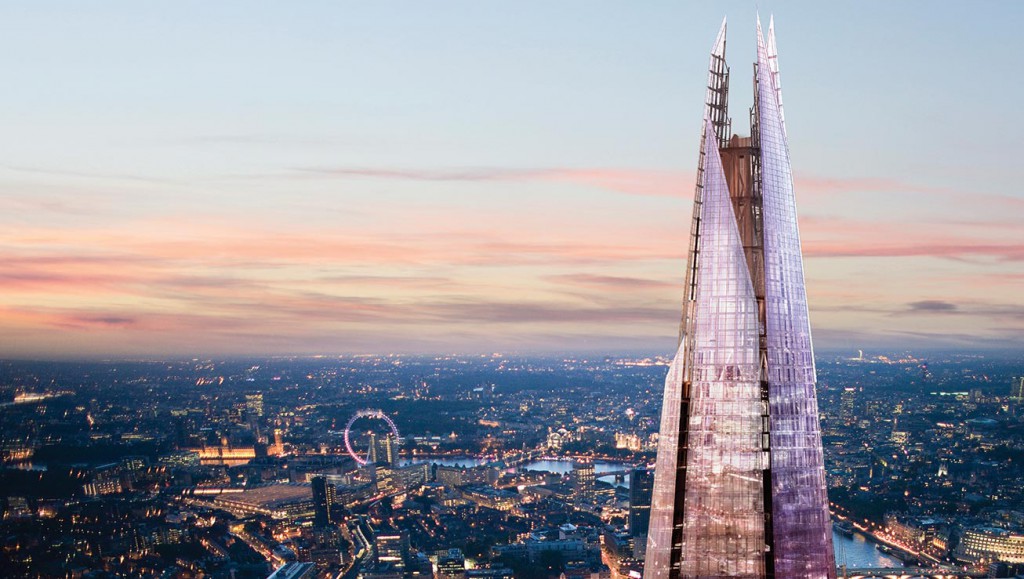
Funding
In late 2007, the gathering uncertainty in the global financial markets sparked concerns about the viability of the Shard. However, in January 2008, Sellar announced that it had secured funding from a consortium of Qatari investors, who had paid £150 million to secure an 80% stake in the project. The consortium included Qatar National Bank, QInvest, Qatari Islamic Bank and the Qatari property developer Barwa Real Estate, as well as Sellar Property. The deal involved a buyout of the Halabi and CLS Holdings stakes, and part of the Sellar Property stake. The new owners promised to provide the first tranche of finance, allowing construction of the tower to begin. In 2009, the State of Qatar consolidated its ownership of London Bridge Quarter (known now as Shard Quarter), including The Shard, through the purchase of the private Qatari investors’ stakes. Shard Quarter is today jointly owned by the State of Qatar and Sellar.
資金
2007年底,全球金融市場的不確定性引發了對碎片生存能力的擔憂。 然而,在2008年1月,塞拉爾宣布已從卡塔爾投資者財團獲得資金,這些投資者已支付1.5億英鎊以獲得該項目80%的股份。 該財團包括卡塔爾國家銀行,QInvest,卡塔爾伊斯蘭銀行和卡塔爾房地產開發商Barwa Real Estate以及Sellar Property。 該交易涉及收購Halabi和CLS Holdings的股份,以及Sellar Property股權的一部分。 新業主承諾提供第一筆融資,允許建造塔樓。 2009年,卡塔爾國通過購買私人卡塔爾投資者的股權,鞏固了其對倫敦橋區(現稱為Shard Quarter)的所有權,包括The Shard。 Shard Quarter今天由卡塔爾國和塞拉爾共同擁有。
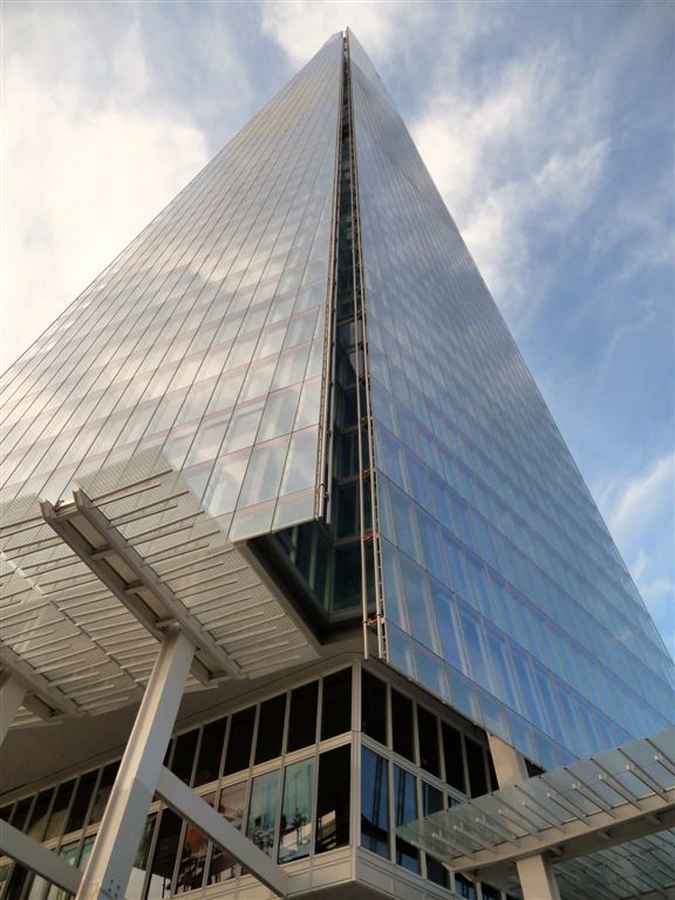
Architecture
Renzo Piano, the project’s architect, designed The Shard as a spire-like sculpture emerging from the River Thames. He was inspired by the railway lines next to the site, the London spires depicted by the 18th-century Venetian painter Canaletto, and the masts of sailing ships.Piano’s design met criticism from English Heritage, who claimed the building would be “a shard of glass through the heart of historic London”, giving the building its name, The Shard. Piano considered the slender, spire-like form of the tower a positive addition to the London skyline, recalling the church steeples featured in historic engravings of the city, and believed that its presence would be far more delicate than opponents of the project alleged. He proposed a sophisticated use of glazing, with expressive façades of angled glass panes intended to reflect sunlight and the sky above, so that the appearance of the building will change according to the weather and seasons. The building features 11,000 panes of glass, with a total surface area of 602,779 square feet (56,000.0 m2) equivalent to the area of almost eight Wembley football pitches.
The Shard was designed with energy efficiency in mind. It is fitted with a combined heat and power (CHP) plant, operating on natural gas from the National Grid. Fuel is efficiently converted to electricity, and heat is recovered from the engine to provide hot water for the building.
Following the destruction of New York’s World Trade Center (WTC) in the terror attacks of 11 September 2001, architects and structural engineers worldwide began re-evaluating the design of tall structures. The Shard’s early conceptual designs were among the first in the UK to be amended following the publication of the US National Institute of Standards and Technology (NIST) report into the collapse of the WTC. The building is designed to maintain its stability under very onerous conditions,with its post-tensioned concrete and composite floors, load-bearing pillars and tapering shape giving it a sway tolerance of 400 millimetres (16 in).
In 2014, The Shard claimed first place at the Emporis Skyscraper Awards, recognising buildings over 100 m (328 ft) completed in the previous twelve months. The Emporis judges hailed the building as “a skyscraper that is recognized immediately and which is already considered London’s new emblem”.
建築
該項目的建築師Renzo Piano將The Shard設計為泰晤士河上的尖頂雕塑。他的靈感來自於該遺址旁邊的鐵路線,18世紀威尼斯畫家卡納萊托描繪的倫敦尖頂,以及帆船桅杆.Piano的設計遭到了英國遺產的批評,他們聲稱這座建築將成為“通過歷史悠久的倫敦中心的玻璃“,給建築物起名,碎片。鋼琴被認為是塔上的正面除了倫敦天際線的修長,塔尖狀,回顧城市的歷史版畫特色的教堂尖塔,並認為它的存在將遠遠小於據稱該項目的反對者更加細膩。他提出了一種複雜的玻璃窗使用,具有傾斜玻璃窗的表面外立面,旨在反射陽光和上方的天空,因此建築物的外觀將根據天氣和季節而變化。該建築擁有11,000塊玻璃,總面積為602,779平方英尺(56,000.0平方米),相當於八個溫布利足球場的面積。
碎片的設計考慮了能源效率。它配備了熱電聯產(CHP)工廠,使用國家電網的天然氣。燃料被有效地轉換為電力,並且從發動機回收熱量以為建築物提供熱水。
在2001年9月11日恐怖襲擊事件中紐約世界貿易中心(WTC)遭到破壞之後,全世界的建築師和結構工程師開始重新評估高層建築的設計。在美國國家標準與技術研究院(NIST)報告世貿中心崩潰之後,碎片的早期概念設計是英國首批進行修訂的設計之一。該建築設計用於在非常繁重的條件下保持其穩定性,其後張拉混凝土和復合地板,承重支柱和錐形形狀使其具有400毫米(16英寸)的搖擺公差。
2014年,The Shard在Emporis摩天大樓獎中獲得第一名,表彰在過去12個月內完成的超過100米(328英尺)的建築。 Emporis評委稱這座建築為“一座立即被認可的摩天大樓,已被視為倫敦的新標誌”。
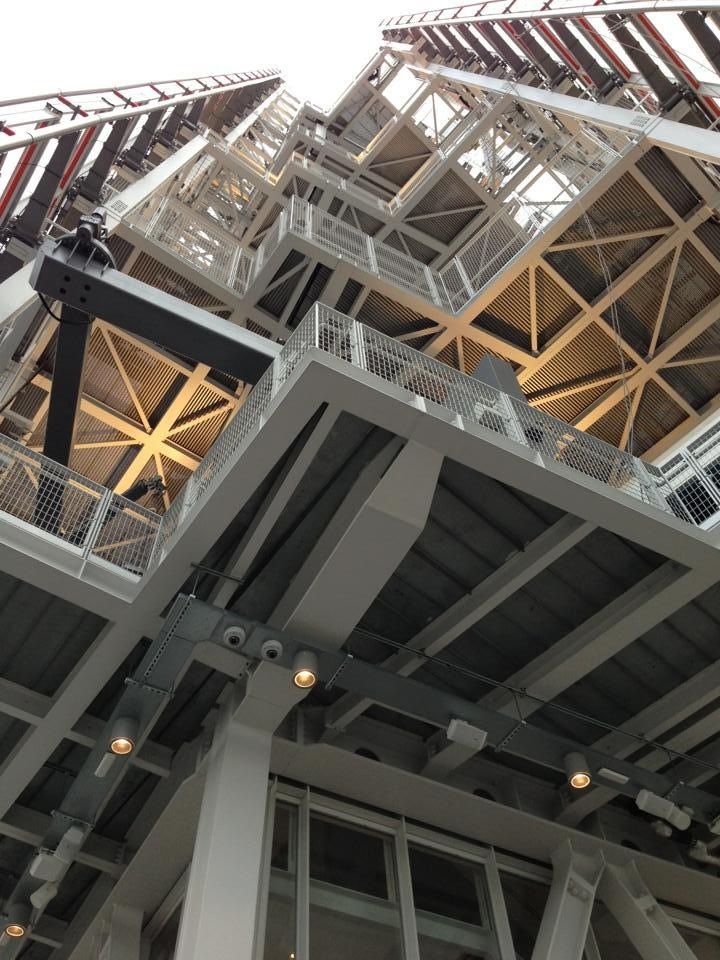
Construction
In February 2009, a mobile crane and a small piling rig arrived on site. In early March 2009, the crane began putting steel beams into the ground, as part of preparations for the core of the building. Full construction began on 16 March 2009. Demolition work on New London Bridge House started in May 2009, as part of the concurrent London Bridge Place project. The first steelwork went into The Shard’s piles on 28 April. Five cranes were used to build The Shard, with four of them ‘jumping’ with the tower as it rose. Crane 1 was erected in September 2009 and Crane 2 was erected at the beginning of October. By 20 October 2009, steel beams began appearing on site, with concrete being poured at the northern part of the site, ready for Crane 3.
By March 2010, the concrete core was rising steadily at about 3 metres (9.8 ft) a day. After a pause in March–April 2010, it continued rising, reaching the 33rd floor in mid-June, almost level with the top of Guy’s Hospital, which stands at 143 metres (469 ft). On 27 July 2010, the core stopped rising, having reached the 38th floor, and was reconfigured for further construction. By mid-November 2010, the core had reached the 68th floor, with the tower’s steel reaching the 40th floor and glass cladding enveloping a third of the building. In late November, the core’s height exceeded 235 metres (771 ft), ending One Canada Square’s 18-year reign as Britain’s tallest building.
The Shard’s concrete core topped out at the 72nd floor in early 2011, standing at 244 metres (801 ft). The early part of January 2011 saw the installation of hydraulic screens, which were used to form the concrete floors of the hotel and apartment section of the tower, and rose with the floors up to the 69th floor. On 25 January 2011, the concrete pumps began pouring the first concrete floor at the 41st floor. By the end of February 2011, concrete flooring had risen to the 46th floor, with a new floor being poured on average every week. The cladding of the structure also progressed, mainly on the tower’s “backpack”.
August 2011 saw steady progress in construction, with cladding enveloping more than half the building’s exterior. Pouring of the concrete floors reached the 67th floor, and progression on the tower’s cladding reached the 58th floor. By mid-August, the core box had been removed. By 19 September 2011, the tower’s steel was approaching the height of the completed core, reaching almost 244 metres (801 ft). On 24 September, a final crane – at the time, the tallest ever built in Britain – was erected to install the skyscraper’s upper spire. The spire was pre-fabricated and pre-assembled based upon 3D models, and underwent a “test run” in Yorkshire before being lifted onto the building itself. By late December 2011, the Shard had become the tallest building in the European Union, superseding the Commerzbank Tower in Frankfurt, Germany.
The Shard’s steel structure was topped out on 30 March 2012, when its 66-metre (217 ft), 500-tonne spire was winched into place. The steel structure thus reached a height of 308.5 metres (1,012 ft). The final 516 panes of glass were added shortly after, topping the tower out at its full height of 309.6 metres (1,016 ft).
The Shard was inaugurated on 5 July 2012 by the Prime Minister of Qatar, Hamad bin Jassim bin Jaber Al Thani, in a ceremony attended by Prince Andrew, Duke of York. The inauguration ceremony featured a laser light show comprising 12 lasers and 30 searchlights, which illuminated the building on the London skyline. Practical completion of the building was achieved in November 2012.
施工
2009年2月,一台移動式起重機和一個小型打樁鑽機抵達現場。 2009年3月初,起重機開始將鋼樑放入地下,作為建築核心準備工作的一部分。 2009年3月16日開始全面建設。作為倫敦橋廣場項目的一部分,新倫敦橋樓的拆除工作於2009年5月開始。第一個鋼結構於4月28日進入碎片堆。五個起重機被用來建造碎片,其中四個與塔一起“跳躍”起來。 Crane 1於2009年9月豎立起,Crane 2於10月初豎立起來。到2009年10月20日,鋼樑開始出現在現場,混凝土澆築在場地的北部,為Crane 3做好準備。
到2010年3月,混凝土芯每天穩定上升約3米(9.8英尺)。在2010年3月至4月暫停後,它繼續上升,在6月中旬達到33層,幾乎與Guy醫院的頂部水平相當,該醫院位於143米(469英尺)處。 2010年7月27日,核心停止上升,已經到達38層,並進行了重新配置以進一步施工。到2010年11月中旬,核心已達到68層,塔樓的鋼材達到40層,玻璃覆層包圍了建築的三分之一。 11月下旬,核心高度超過235米(771英尺),結束了加拿大廣場18年的統治,成為英國最高的建築。
Shard的混凝土核心於2011年初位於第72層,位於244米(801英尺)處。 2011年1月初,安裝了液壓屏幕,用於形成塔樓的酒店和公寓區域的混凝土地板,並在地板上升至69層。 2011年1月25日,混凝土泵開始澆注第41層的第一層混凝土地板。到2011年2月底,混凝土地板已升至46層,每周平均澆築一層新地板。結構的包層也在進步,主要是在塔的“背包”上。
2011年8月,建築業取得穩步進展,包層覆蓋了建築外部的一半以上。混凝土地面的澆築到達了67層,塔樓的覆層進展到了58層。到8月中旬,核心盒已被移除。到2011年9月19日,塔的鋼材接近完工核心的高度,達到近244米(801英尺)。 9月24日,最後一台起重機 – 當時是英國有史以來最高的起重機 – 被豎立起來安裝摩天大樓的上部尖頂。該尖頂是根據3D模型預製和預組裝的,並在被提升到建築物本身之前在約克郡進行了“試運行”。截至2011年12月底,碎片已成為歐盟最高的建築,取代德國法蘭克福的德國商業銀行大廈。
Shard的鋼結構於2012年3月30日完成,當時其66米(217英尺),500噸的尖頂被絞合到位。因此,鋼結構的高度達到308.5米(1,012英尺)。不久之後,最後的516塊玻璃被添加到塔頂,其高度為309.6米(1,016英尺)。
2012年7月5日,卡塔爾總理哈馬德·本·賈西姆·本·賈比爾·阿勒薩尼在約克公爵安德魯王子出席的儀式上宣誓就職。就職典禮上的激光錶演包括12個激光和30個探照燈,照亮了倫敦天際線上的建築。 2012年11月實現了該建築的實際完工。
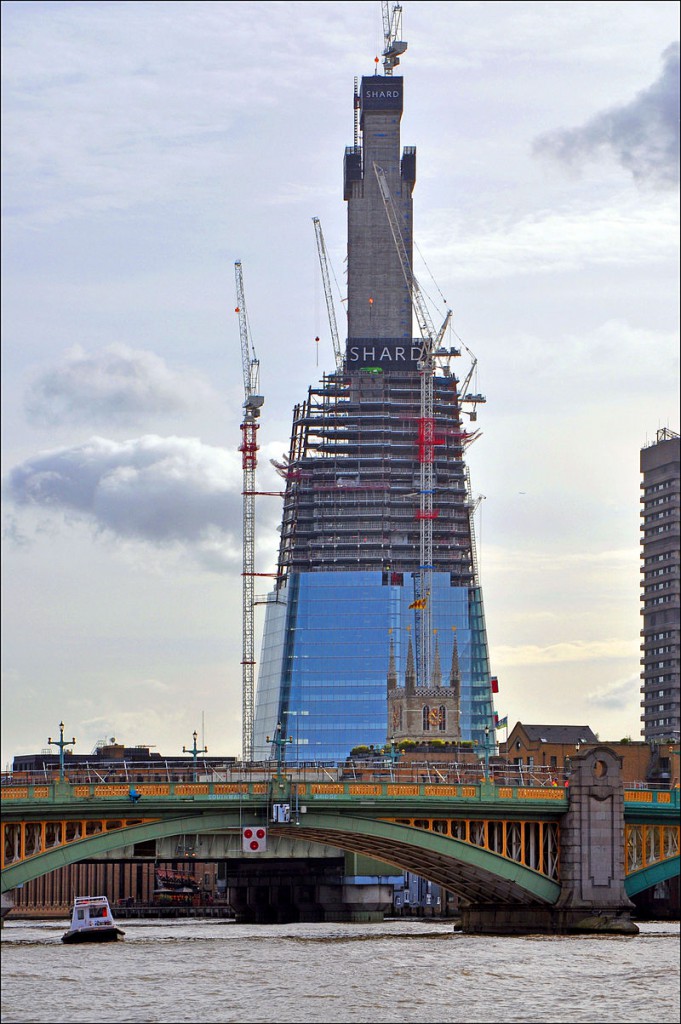
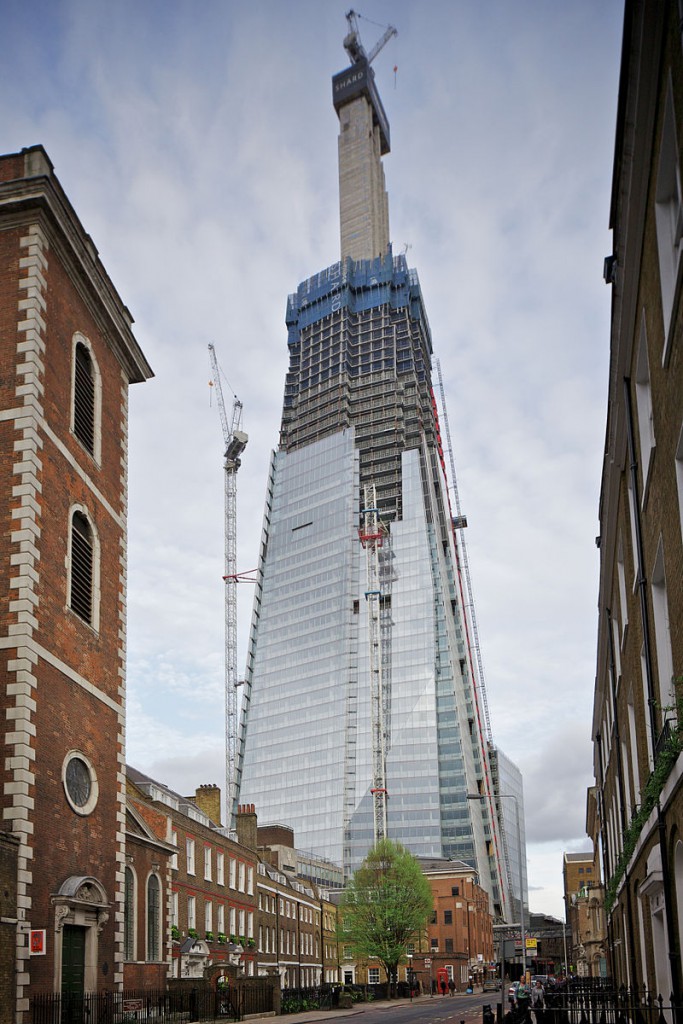
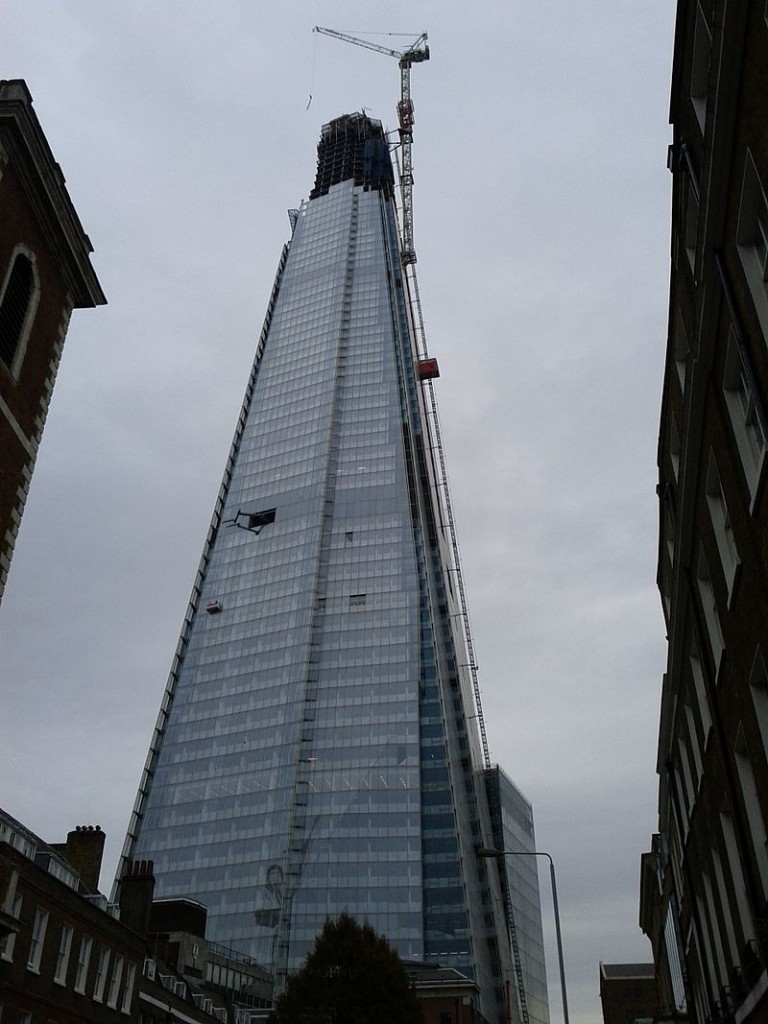
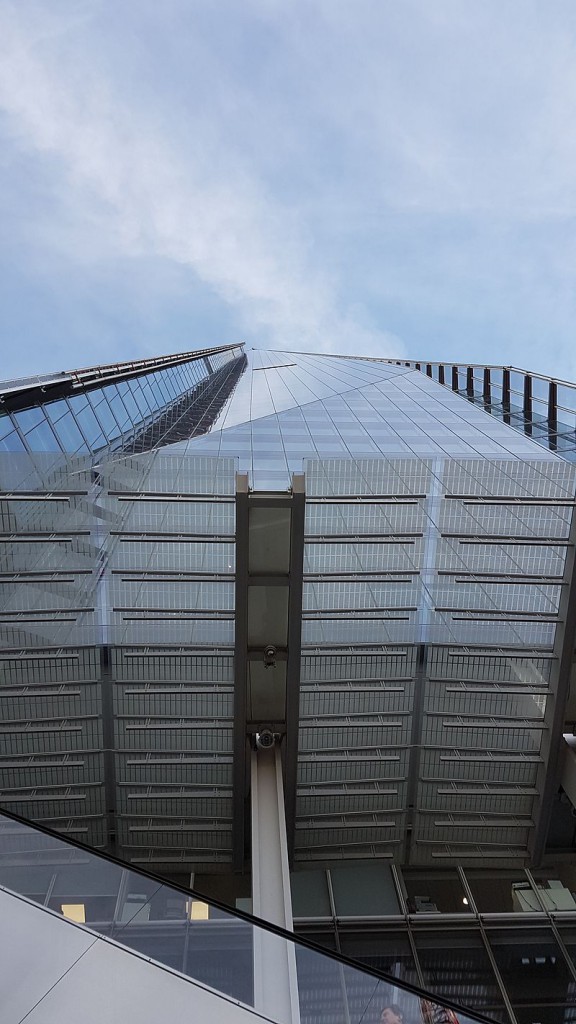
FROM:https://en.wikipedia.org/wiki/The_Shard
FROM:Constructing the Shard Mega Tower
FROM:Shangri La Hotel, At The Shard, London – Some Welcomes Are Beyond Words
Don’t you think it’s addictive?
Want to know more about the beauty of architecture?
Come and join our members to explore the beauty of architectural design.
覺得看得不過癮嗎?
想要知道更多建築之美嗎?
快來加入我們的會員,一同探索建築設計之美。
The above article is purely for appreciation and sharing purposes, as well as the construction of new technology and the public can be in-depth understanding of the information at the same time there are sources, will be able to query, no use of the document as a commercial transaction, if illegal, please inform the We will immediately remove the site, thank you for cooperation.
以上文章純粹作為欣賞及分享用途,以及將建築新型技術傳遞給與大眾能夠深入了解,同時資料還有來源,將可查詢,絕無使用該文件資料作為商業交易行為,如有違法請務必告知該網站我們將立即處理撤除,謝謝合作。

